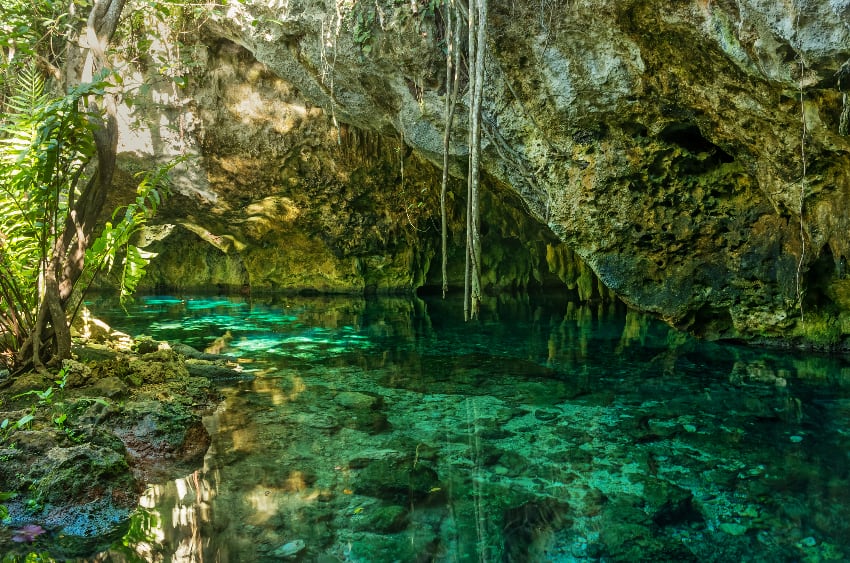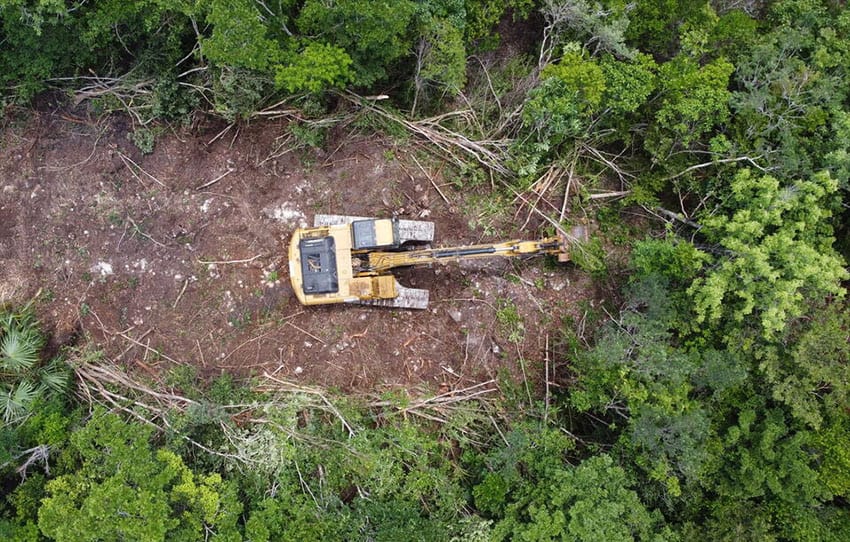Steel and cement pilings that pierce through the roofs of limestone caves along a section of the Maya Train railroad have affected the quality of subterranean water and destroyed “archaeological and geological heritage,” experts say.
Members of two environmental groups that assert that the construction and operation of the Maya Train railroad is harming the environment visited caves in the Aktun T’uyul system south of Playa del Carmen in Quintana Roo on Sunday.
🧵[1/5]
🔴El Tren Maya acuchilla el sistema de cuevas y cenotes de Quintana Roo🗞️EL PAÍS recorre con espeleólogos una de las 122 cavernas impactadas por la construcción contrarreloj de más de 10.000 pilares
🖊️@BeaGTorres
📸🎥 @gladys_serrano
🔗https://t.co/hcPPLkorKp pic.twitter.com/MEFvSYlRku— EL PAÍS México (@elpaismexico) January 24, 2024
In photos and videos, they documented pilings that penetrate the roofs of caves in that complex.
The pilings, or columns, support an elevated section of track along Section 5 of the railroad, parts of which were inaugurated in late 2023. The elevation of the tracks was supposed to avoid damaging the caves and cenotes (natural sinkholes) that are ubiquitous in Quintana Roo and other parts of the Yucatán Peninsula.
In one video filmed on Sunday, hydrologist Guillermo D’Christy points out two of an apparent 12 pilings that were driven through the roofs of caves in the Aktun T’uyul complex.
“It was supposed that we were going to protect this system of caves and cenotes, the promise was they weren’t going to be touched, that’s what [National Institute of Anthropology and History Director] Diego Prieto said,” D’Christy says in his video.
“They lied to us because [the caves] are perforated and concrete is being injected into them,” he adds.
“The next [federal] administration will have a very big job because it will have to look at how to make amends for and mitigate all this damage being caused to the Yucatán Peninsula. … Putting a train through the jungle is the worst ecocide ever committed in this place.”
Impact on water quality the main concern
In addition to destroying the structure of the caves, D’Christy and biologist and speleologist Roberto Rojo say that the pilings have affected the quality of subterranean water, which is normally crystal clear but is now murky.
The two men, both of whom spoke to the El Universal newspaper, expressed concern about the potential impact of the corrosion of metal in the pilings on subterranean water in cenotes and rivers.

The biggest issue “of all this devastation and unlawfulness has to do with water,” D’Christy said.
“Two million [Quintana Roo] residents depend on water to live and if it’s contaminated, it will be terrible,” he said.
Rojo said it was unclear whether the murkiness of the water would be permanent or only last while work on that section of the railroad is taking place.
“We don’t know what the effect of the rusting of the structures will be and in general we don’t know what exact impacts these pilings will have because this wasn’t assessed with scientific rigor,” he said.
“As a speleologist, when I saw … the image of the piling crossing the cave, it made me very sad because the impact on the archaeological and geological heritage is irreversible,” said Rojo, who denounced the destruction of stalactites and stalagmites that are 800,000 years old and noted that the remains of ancient humans and “animals from the [last] Ice Age” have been found in the caves.
He also said that the installation of the pilings affects the humidity, temperature and light in the caves, which could affect native species that live in them. Rojo added that there is concern among cave divers about water quality in Quintana Roo, which he said is recognized around the world as “the Mecca of cave diving.”
D’Christy says that at least 122 caves, cenotes and subterranean rivers have already been affected by work along Section 5 of the railroad, which is slated to open next month.
“President López Obrador lied [about protecting them],” he told the Reforma newspaper, adding that experts warned that there was no way of avoiding damage to the caves and underground waterways.
D’Christy said that while some caves with cenotes have had pilings drilled into them, others have been completely filled in.
“We’re talking about ancient formations, a habitat that is unique in the world. … The big problem is that they’re putting steel and concrete pilings in Mexico’s most important aquifer after the Usumacinta River and changing the chemistry of the fresh water,” he said.
Experts have also warned that sections of the railroad could collapse given that tracks have been built over karst, terrain formed from soluble carbonate rocks such as limestone.

The federal government’s pledge to protect caves and cenotes
President López Obrador promised that the construction and operation of the Maya Train railroad — one of his government’s signature infrastructure projects — wouldn’t have a negative impact on caves and subterranean waterways on the Yucatán Peninsula.
In May last year, he pledged that cenotes, underground rivers and caves would all be protected.
In 2022, a judge in Mérida, Yucatán, issued a provisional suspension order against the construction of the Maya Train railroad between Playa del Carmen and Tulum due to the “imminent risk” of “irreversible damage” to the Mayan jungle, caves, subterranean rivers and cenotes and the absence of environmental studies and permits.
However, the government succeeded in having that order, and other rulings against the construction of the 1,554-kilometer-long railroad, overturned.
El Universal reported that the installation of pilings along Section 5 of the railroad was “superficially mentioned” in an environmental impact statement submitted to the federal Environment Ministry in May 2022, but it didn’t say where they would be placed or how many would be used, and didn’t specify what impact they would have on the environment.
The conglomerate Grupo México and Spanish firm Acciona were contracted to build Section 5 of the railroad, but the government terminated their contract in 2022 and the Ministry of National Defense took over the project.
Jorge Escobar, a biologist, told El Universal that soil mapping studies — which could have prevented pilings entering caves — were not carried out.

Large swathes of jungle were cut down to build the railroad in Quintana Roo due to a route change, a move that triggered protests from numerous environmental groups and activists.
The Sélvame del Tren collective — whose name means “save the jungle from the train” or “save me and the jungle from the train” — has been among the most vocal critics of the multi-billion-dollar project. Its activists were among the environmentalists that documented the pilings during the visit to the Aktun T’uyul caves on Sunday.
There have long been concerns about the risks the construction and operation of the Maya Train pose to the environment and wildlife including jaguars.
López Obrador — who asserts that the railroad will help bring economic prosperity to Mexico’s disadvantaged southeast — has largely rejected opposition to the project on environmental grounds, and described critics as “pseudo-environmentalists.”
The entire railroad — which runs through Tabasco, Campeche, Yucatán, Quintana Roo and Chiapas — is slated to be operational before the end of next month.
With reports from El Universal and Reforma
